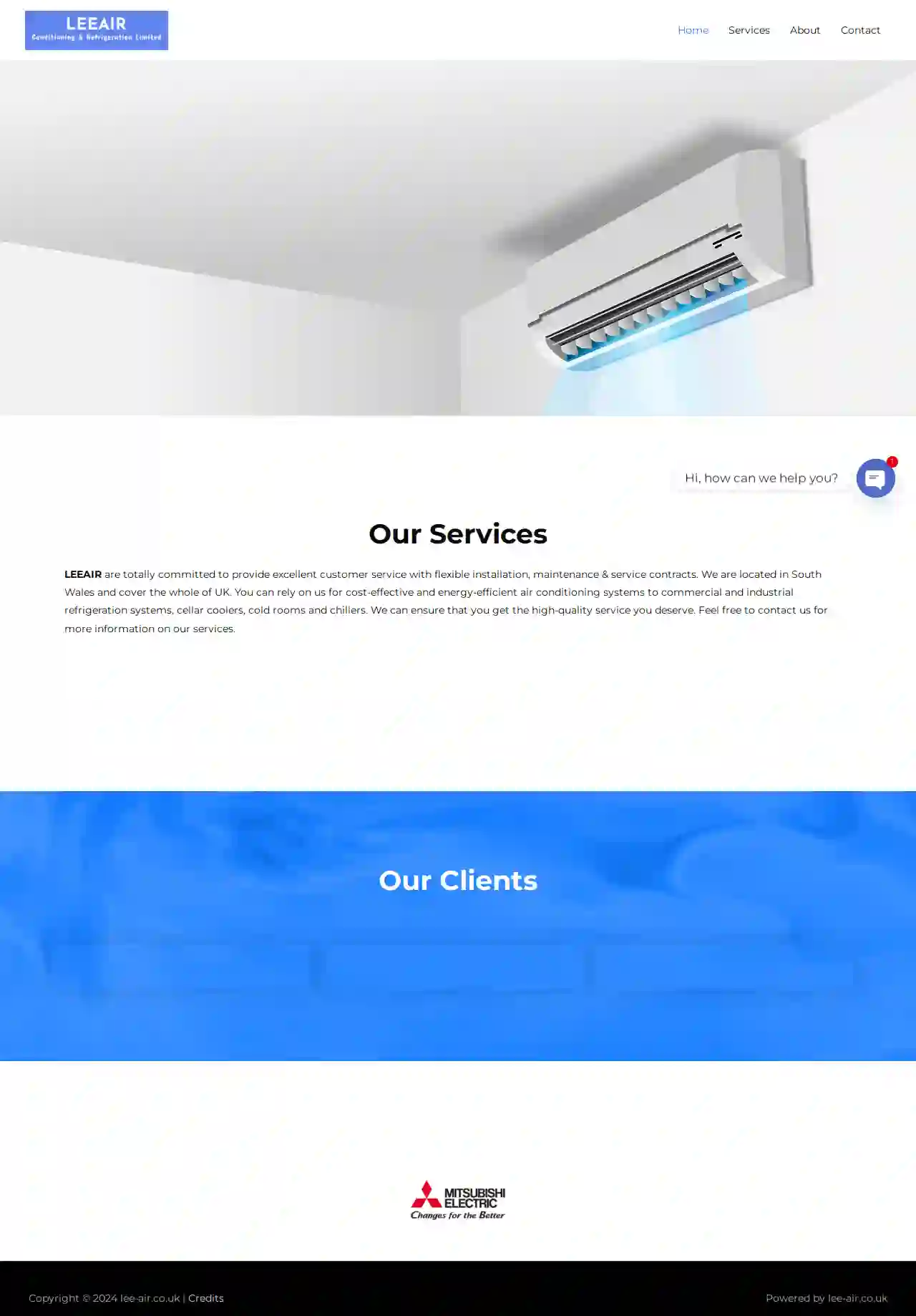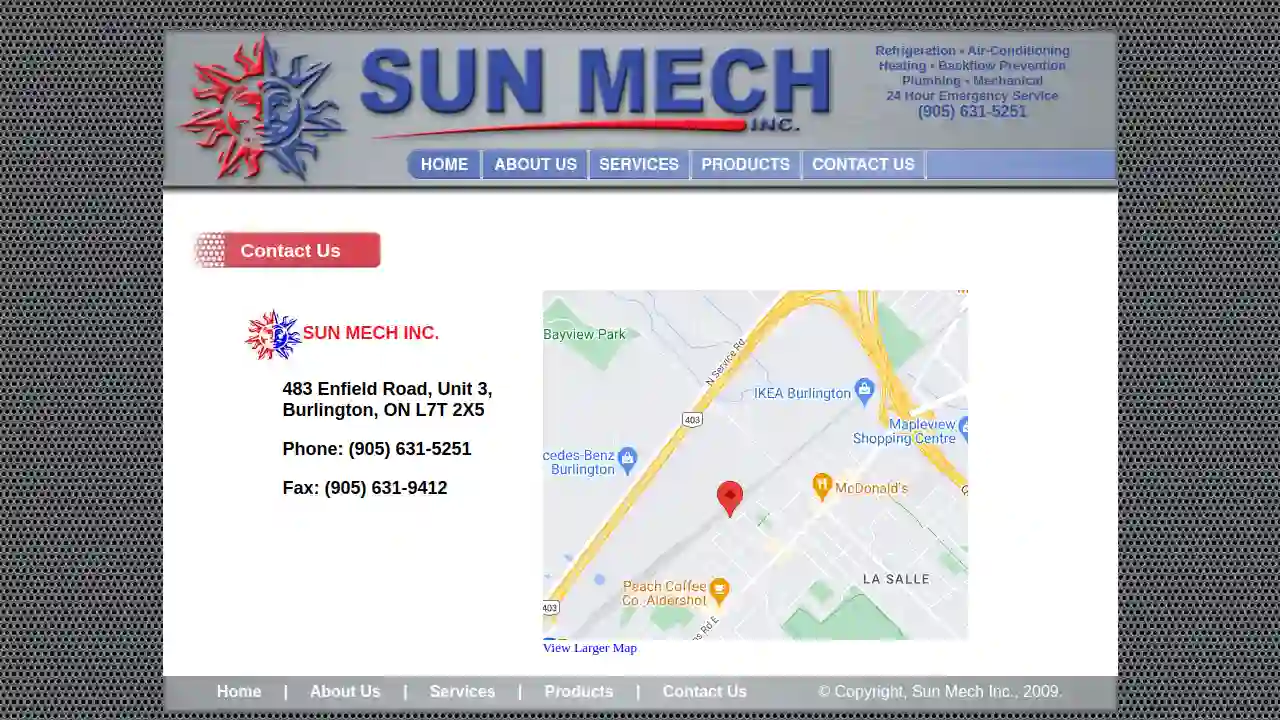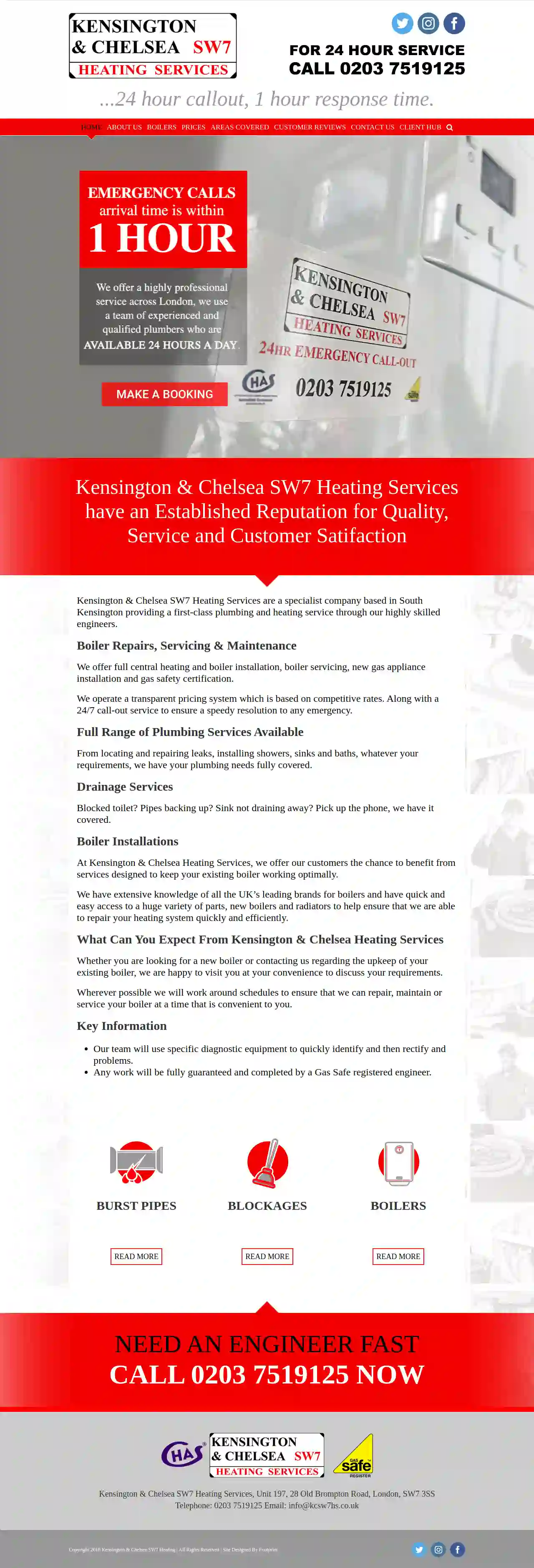Furnace Repair Tottenham
Top 10 Furnace Repair in Tottenham
Get up to 3 Furnace Service quotes for your project today! Compare profiles, reviews, accreditations, portfolio, etc... and choose the best deal.

LEEAIR Conditioning and Refrigeration Limited
4.25 reviewsEnfield, GBLEEAIR are totally committed to providing excellent customer service with flexible installation, maintenance & service contracts. We are located in South Wales and cover the whole of the UK. You can rely on us for cost-effective and energy-efficient air conditioning systems to commercial and industrial refrigeration systems, cellar coolers, cold rooms and chillers. We can ensure that you get the high-quality service you deserve. Feel free to contact us for more information on our services.
- Services
- Why Us?
- Gallery
Get Quote
North London Plumbing & Heating - Domestic Plumber, Boiler Installations & Repairs Palmers Green
53 reviewsPalmers Green, North London, 16c Broomfield Lane, N13 4HB, GBNorth London Plumbing Heating & Builders Ltd is a trusted and reliable plumbing company in North London, with 30 years of experience. We pride ourselves on delivering exceptional service to our valued customers, with a commitment to quality, integrity, and innovation. Our team of highly skilled and experienced professionals is dedicated to understanding your unique needs and bringing your vision to life. We believe in open communication and collaboration with our clients throughout the entire plumbing process, ensuring that your expectations are met and exceeded.
- Services
- Why Us?
- Testimonials
- Gallery
Get Quote
Peter O'Neill Services
4.135 reviewsLlanyravon, Cwmbran, Unit 1 Grange Industrial Estate, NP44 8HQ, GBFormed in 1963 by Peter O’Neill Snr. in Cwmbran, we have built up a loyal customer base and reputation for providing high quality central heating installations and maintenance cover throughout South Wales and beyond. Nearly 60 years experience in plumbing and central heating. Fully qualified and registered engineers. Family run and local workforce. Free no obligation assessments and quotes. Public liability insurance up to £5 million. Full service and maintenance plans available. Over 5,000 customers across South Wales and The West trust us to look after their boiler, central heating and gas appliances.
- Services
- Why Us?
- Gallery
Get Quote
Heatmaster London Ltd.
551 reviews67 Daneland, Barnet, EN4 8PZ, GBHeatmaster London has been serving the Greater London area since 2007, providing fast, friendly, trustworthy, and professional service. Whether you need routine maintenance, emergency repairs, or a FREE, NO-OBLIGATION ESTIMATE for replacing outdated boilers, our certified technicians are dedicated to ensuring your heating and cooling systems run efficiently. We understand that when you have a problem, you want it fixed quickly, affordably, and confidently, whether you're a homeowner, business owner, property manager, or contractor. We take pride in our team of Gas Safe registered engineers who are highly qualified and experienced. They have previously worked for major manufacturers like British Gas, Worcester, Vaillant, and Baxi, and are accredited installers for leading brands such as Vaillant, Worcester Bosch, Baxi-Potterton, Viessmann, and Ideal. This means you can be confident that your boiler installation, repair, and service will be carried out to the highest industry standards at competitive prices. All our repair work comes with a one-year warranty for your peace of mind.
- Services
- Why Us?
- Accreditations
- Gallery
Get Quote
Baxter Heating
4.815 reviews5 Ashleigh Court, Henllys, Cwmbran, NP44 6HF, GBBaxter Heating is a Gas Safe Registered business that provides gas boiler installation, service, and repair throughout Newport, including Risca, Rogerstone, and Highcross, plus Cwmbran and the South Wales area. Our engineers and plumbers are Gas Safe Registered and benefit from extensive product training on all leading manufacturer's equipment. We specialise in domestic, industrial, and commercial heating and gas, mechanical, and maintenance works. Our industrial and commercial gas engineers are fully trained and qualified; hold statutory qualifications and specific work-based training such as working at height training, harness training, ladder training, and confined space training. We regularly carry out internal audits of work carried out to maintain our own high standards and continued investment in work-based training for engineers ensures a professional service. We have a strict health and safety policy, an excellent health and safety framework, and can easily accept blue chip customers as clients. We are committed to energy efficiency and carbon reduction and offer some of the most innovative products available to help our clients achieve real energy savings with a minimal environmental impact.
- Services
- Why Us?
- Our Team
- Testimonials
- Gallery
Get Quote
Sun Mech Inc
4.510 reviews483 Enfield Road, Unit 3, Burlington, L7T 2X5, GBSUN MECH INC. is a full-service mechanical contractor serving the Greater Toronto Area. We specialize in HVAC, Refrigeration, Plumbing, and Backflow Prevention. Our team of experienced technicians is dedicated to providing high-quality workmanship and exceptional customer service. We are committed to exceeding your expectations and ensuring your complete satisfaction. We offer a wide range of services, including: HVAC Refrigeration Plumbing Backflow Prevention We are available 24 hours a day, 7 days a week for emergency service. Contact us today to learn more about our services or to schedule a consultation.
- Services
- Why Us?
- Gallery
Get Quote
Inspire Air Conditioning Ltd
51 reviews10 Waterside Court, Albany Street, Newport, NP20 5NT, GBInspire Air Conditioning Ltd provides supply, installation, service and repairs of air conditioning and ventilation systems. We’re a team of fully-certified professionals who tackle everything from complex, large projects to smaller-scale jobs. Fuelled by our commitment to excellence, we go the extra mile to make sure clients are completely satisfied with our work.
- Services
- Why Us?
- Gallery
Get Quote
Argoclima Air Conditioning UK
4.29 reviews282 Chase Road, London, N14 6NZ, GBGreen Living Trading LTD T/A GREEN LIVING HVAC has been established since 2016 and focuses on providing HVAC solutions to residential and commercial projects. Our services include supply and fit of all types of airconditioning and HVAC solutions, whether it is small domestic project to large installations, including offices, hotels and much more. Our airconditioning and ventilation installation are all carried out by our own engineers, covered by an extensive professional indemnity warranty, and our work is carried out under F Gas and Refcom regulations. Our air conditioning systems comes with a standard 1 year warranty which is extended to 5 years when your unit is installed by one of our qualified installers. Our Complete Solution from £1295 get a free quote today!
- Services
- Why Us?
- Accreditations
- Gallery
Get Quote
cordy heating
1.52 reviewsEnfield, GBYour Local Gas Engineer in Upper Cwmbran Do you need a gas engineer in Upper Cwmbran? Our members provide plumbing and heating services in Upper Cwmbran and the surrounding areas. From plumbing repairs and entire central heating system replacements, they’ve got you covered. We only work with Gas Safe registered engineers, to ensure that all your repairs and replacements are completed safely and efficiently. Plumbing & Heating Services If you’ve got a burst pipe or your hot water won’t kick correctly, then it is important you contact a professional today. Our members work with a wide range of domestic customers across Upper Cwmbran and the wider surrounding area. Some of the plumbing and heating services our members provide include: Boiler Repairs Central Heating Installations Installing of Boilers Boiler Health Checks and Servicing Upgrading Boilers Radiator Fitting Bathroom Installation Why Choose Us? South Wales Heating Co members are all Gas Safe registered heating engineers taking care of all your heating and water installations, repairs, replacements, kitchen installations, tiling or even the smallest of plumbing jobs like dripping taps and leaking showers. Plumbing Power Flushing Boiler Installs Boiler Servicing Boiler Repairs Contact South Wales Heating Co For more information about the services our members provide to our customers in Upper Cwmbran, get in contact today. Our members are always on hand to install, repair and replace a variety of plumbing, heating and bathroom fittings
- Services
- Why Us?
- Gallery
Get Quote
Kensington & Chelsea Heating Services Ltd
565 reviewsUnit 197, 28 Old Brompton Road, London, SW7 3SS, GBKensington & Chelsea SW7 Heating Services is a specialist heating company based in South Kensington providing first-class workmanship to its customers. We are a small, local, customer-driven company with a team of highly experienced engineers who are experts in their field. With many years experience of working in the plumbing & heating sector, we are ideally positioned to install, maintain, service, upgrade and repair all central heating systems throughout London. We are very proud of our reputation for providing outstanding customer service and generating outstanding results time after time. Not only do we cover all aspects of plumbing, heating and gas related work in Kensington & Chelsea and the surrounding area, we also provide a 24-hour emergency call-out service. The Kensington & Chelsea SW7 Heating Services Philosophy Kensington & Chelsea SW7 Heating Services aim to keep things simple. Provide excellent value for money, work quickly and tidily and provide long lasting results each and every time. Our team of plumbers will arrive when they say they will and we will do all that we can to provide you with a level of service that you will be happy to recommend to family and friends. Transparency We do not charge a call-out fee & we also provide free estimates. Our labour charges are competitive and no hidden costs are added to your bill once the work has been completed. The following rates do not include cost of materials or VAT.
- Services
- Why Us?
- Accreditations
- Gallery
Get Quote
Over 12,692+ HVAC Businesses registered
Our HVAC contractors operate in Tottenham and beyond!
HVACCompaniesHub has curated and vetted Top HVAC Businesses near Tottenham. Find a reliable business today.
Frequently Asked Questions about Furnace Repair
- Licensed and Insured: Ensure the company has the necessary licenses and insurance to operate in your area.
- Experienced: Look for a company with a proven track record in furnace repair. Ask how long they've been in business and if they specialize in your furnace type..
- Reputable: See what other customers say. Referrals from friends, family, or neighbors can be valuable.
- Transparent Pricing: Ask for a detailed estimate before any work begins.
- Available 24/7 (for emergencies): If you experience a furnace breakdown outside of regular business hours, make sure the company offers 24/7 emergency repair service.
- Age: If your furnace is 15-20 years old or older, it's likely less efficient and more prone to breakdowns.
- Frequent Repairs: Repeated service calls can mean underlying problems.
- High Energy Bills: A noticeable increase in your heating bills could mean an inefficient furnace.
- Uneven Temperatures: If you have cold spots, it could be a sign of problems with your furnace or ductwork.
- Strange Noises: Unusual or loud sounds can signal problems with the blower motor, igniter, or other components..
- Yellow or Flickering Burner Flame: A healthy furnace flame should be blue. A yellow or flickering flame can indicate a variety of issues. This should be addressed right away.
- Dry or Dusty Air: An old furnace can contribute to dry, dusty indoor air. A new furnace with improved filtration can help alleviate this problem.
- Change the air filter regularly (every 1-3 months): A dirty filter restricts airflow, reducing efficiency and potentially damaging the system.
- Schedule an annual furnace tune-up: A professional technician can inspect, clean, and test all components, ensuring optimal performance and safety.
- Keep the area around the furnace clear: Remove any flammable materials or obstructions that could block airflow.
- Check and clean the furnace vents: Make sure vents are not blocked by furniture or other items.
- Install a programmable thermostat: This helps optimize heating schedules and save energy.
- Seal air leaks around windows and doors: This prevents heat loss and improves efficiency.
- No Heat or Reduced Heat Output: This can be caused by a variety of issues.
- Strange Noises: Listen for any sounds out of the ordinary.
- Short Cycling: This is when the furnace turns on and off too frequently, reducing efficiency and potentially causing damage.
- Pilot Light/Ignition Problems: In older furnaces, a faulty pilot light can prevent the furnace from igniting. In newer furnaces, issues with the electronic ignition system can cause similar problems.
- Blower Motor Issues: If the blower motor isn't functioning, your furnace may not distribute heat properly. A faulty blower motor requires attention.
- Dirty Air Filter: A clogged air filter restricts air circulation. It may lead to more serious problems.
- Cracked Heat Exchanger: This is a serious safety hazard, as it can lead to carbon monoxide leaks. This is considered an emergency.
How do I find a good furnace repair company?
How do I know when it's time to replace my furnace?
What are some tips for maintaining my furnace?
What are the most common furnace problems?
How do I find a good furnace repair company?
- Licensed and Insured: Ensure the company has proper credentials to operate in your area.
- Experienced: Look for a company with a proven track record in furnace repair. Consider technicians who specialize in your system's make and model.
- Reputable: See what other customers say. Look for companies with positive reviews from previous clients.
- Transparent Pricing: Ask for a detailed estimate before any work begins.
- Available 24/7 (for emergencies): If you experience a furnace breakdown outside of regular business hours, make sure the company offers 24/7 emergency repair service.
How do I know when it's time to replace my furnace?
- Age: If your furnace is 15-20 years old or older, it's likely less efficient and more prone to breakdowns.
- Frequent Repairs: Multiple repairs, especially costly ones, suggest it's more economical to invest in a new, more reliable unit..
- High Energy Bills: A spike in your heating bills might be caused by an inefficient furnace.
- Uneven Temperatures: If you have cold spots, it could be a sign of problems with your furnace or ductwork.
- Strange Noises: Unusual or loud sounds suggest mechanical issues.
- Yellow or Flickering Burner Flame: A healthy furnace flame should be blue. A yellow or flickering flame can indicate a problem with the burners, insufficient airflow, or a dangerous carbon monoxide leak. This should be addressed right away.
- Dry or Dusty Air: An old furnace can contribute to dry, dusty indoor air. A new furnace with improved filtration can help alleviate this problem.
What are some tips for maintaining my furnace?
- Change the air filter regularly (every 1-3 months): A dirty filter restricts airflow, reducing efficiency and potentially damaging the system.
- Schedule an annual furnace tune-up: A professional technician can inspect, clean, and test all components, ensuring optimal performance and safety.
- Keep the area around the furnace clear: Remove any flammable materials or obstructions that could block airflow.
- Check and clean the furnace vents: Make sure vents are not blocked by furniture or other items.
- Install a programmable thermostat: This helps optimize heating schedules and save energy.
- Seal air leaks around windows and doors: This prevents heat loss and improves efficiency.
What are the most common furnace problems?
- No Heat or Reduced Heat Output: This can be caused by a faulty thermostat, a clogged air filter, or a malfunctioning igniter.
- Strange Noises: Listen for any sounds out of the ordinary.
- Short Cycling: This is when the furnace turns on and off rapidly, which can be caused by a faulty thermostat, an overheating furnace, or a clogged air filter.
- Pilot Light/Ignition Problems: In older furnaces, a faulty pilot light can prevent the furnace from igniting. In newer furnaces, issues with the electronic ignition system can cause similar problems.
- Blower Motor Issues: If the blower motor isn't functioning, your furnace may not distribute heat properly. A malfunctioning blower motor can cause reduced airflow, uneven temperatures, and loud noises. should be addressed by a technician.
- Dirty Air Filter: A dirty filter restricts air circulation. It can also cause overheating and damage..
- Cracked Heat Exchanger: This is a serious safety hazard, as it can lead to dangerous gasses entering your home. A cracked heat exchanger needs to be repaired or replaced immediately.